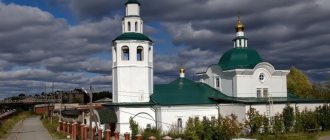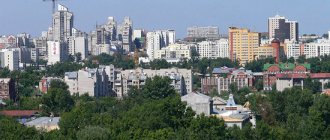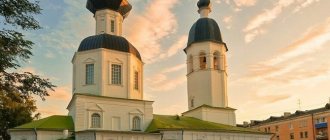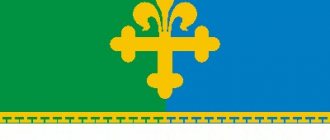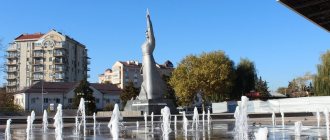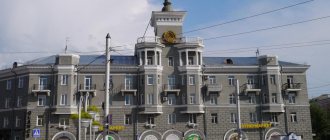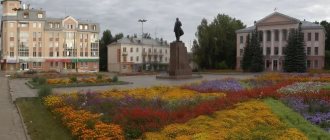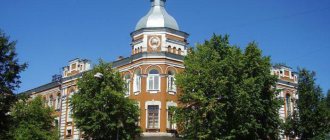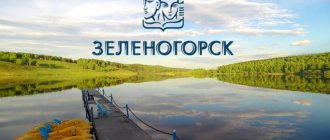The Perm region today is an administrative-territorial division that includes 25 cities, 26 urban-type settlements (urban-type settlements) and also smaller villages, the total population of which is 2,599,260 people. At the same time, the Perm region includes a territory with a total area of 160,237 km2. Thus, the population density here today is 16.22 people / square kilometer.
But the specificity of the distribution of residents here is such that citizens predominantly populate urban areas and urban settlements, but in villages, hamlets and towns the number of residents is insignificant. If we consider these data in percentage terms, then the urban population in the Perm Territory accounts for almost 76%, which indicates an uneven distribution of people throughout the region.
What holiday is it today?
February 10, 2022, Thursday
Today are holidays, events: Diplomat's Day Tomorrow: World Sick Day Discovery of insulin
Today is the Orthodox holiday: St. Ephraim the Syrian. Venerable Ephraim of Novotorzhsky. Venerable Ephraim of Pechersk, Bishop of Pereyaslavl. Venerable Theodosius of Totem, Spasosumorin of the monastery, leader and founder... Tomorrow: Transfer of the relics of the holy martyr Ignatius the God-Bearer. Saints Gerasim, Pitirim, Jonah, bishops of Great Perm, Ustva...
Today is a national holiday: Ephraim's Day... Tomorrow: Lawrence's Day
Content
- 1 Millionaire cities with more than 1 million people 1.1 Perm
- 2.1 Berezniki
- 3.1 Solikamsk
- 4.1 Nytva
Seasons
Seasons, four periods of the year (spring, summer, autumn and winter) characterized by certain average temperatures. The period during which the Sun passes through one of these sectors is called the season. Spring in the Northern Hemisphere and autumn in the Southern Hemisphere begin when the Sun passes through the initial circle of declination and its right ascension is 0° (vernal equinox). Summer in the Northern Hemisphere and winter in the Southern Hemisphere occur when the sun's right ascension is 90° (summer solstice). Autumn in the Northern Hemisphere and spring in the Southern Hemisphere begin when the sun's right ascension is 180° (autumnal equinox). The beginning of winter in the Northern Hemisphere and summer in the Southern Hemisphere is considered to be the winter solstice, when the direct ascension of the Sun is 270°... Next: Seasons. Russian folk calendar. Monthly words...
see also
- Perm region
- Cities of Russia
| [ + ] Cities by regions of Russia | |
| Cities of the North-West (NWFD) | St. Petersburg (and its cities) • Leningrad region (historical Staraya Ladoga) • Arkhangelsk region • Vologda region • Kaliningrad region • Karelia • Komi • Murmansk region • Nenets Autonomous Okrug • Pskov region |
| Cities of the Volga region (Volga Federal District) | Bashkortostan • Volgograd region • Kalmykia • Kirov region • Mari El • Mordovia • Nizhny Novgorod region • Orenburg region • Penza region • Perm region • Samara region • Saratov region • Tatarstan • Udmurtia • Ulyanovsk region • Chuvashia |
| Cities of Southern Russia (SFD) | Sevastopol (including Inkerman) • Republic of Crimea • Adygea • Astrakhan region • Krasnodar region • Rostov region |
| Cities of the North Caucasus (NCFD) | Dagestan • Ingushetia • Kabardino-Balkaria • Karachay-Cherkessia • North Ossetia - Alania • Stavropol Territory • Chechen Republic |
| Cities of the Urals (Ural Federal District) | Kurgan region • Sverdlovsk region • Tyumen region • Khanty-Mansi Autonomous Okrug - Yugra • Chelyabinsk region • Yamalo-Nenets Autonomous Okrug |
| Cities of Siberia (Siberian Federal District) | Altai Republic • Altai Territory • Irkutsk Region • Kemerovo Region • Krasnoyarsk Region • Novgorod Region • Novosibirsk Region • Omsk Region • Tomsk Region • Tyva • Khakassia |
| Cities of the Far East (FEFD) | Amur Region • Buryatia • Jewish Autonomous Region • Trans-Baikal Territory • Kamchatka Territory • Magadan Region • Primorsky Territory • Sakha (Yakutia) • Sakhalin Region • Khabarovsk Territory • Chukotka Autonomous Region |
| see also | Cities of the DPR, LPR, Transnistria, South Ossetia • Regions of Russia • Cities of Russia |
Folk calendar about every day
Every day one season always replaces another and this determines a person’s way of life. In connection with this, a folk calendar was formed in which there were practically no nameless, unmarked days. Every day was special, had its own purpose. All this was determined by climate conditions and astrological phenomena.
A calendar is a system for counting periods of time. The first calendars arose a long time ago, in ancient times, because there was a need to measure time. The word calendar comes from the Latin words caleo - to proclaim and calendarium - debt book. This is due to the fact that in Ancient Rome the beginning of each month was especially proclaimed, and because it was customary to pay debts on the first day of the month. Different peoples counted time differently. Some calendars are based on the changing phases of the moon - lunar calendars; in others - the change of seasons - sunny; in others, the length of the year was coordinated with the change of seasons, and the counting of months was associated with the phases of the Moon. Such calendars are called lunisolar.
In Rus', the calendar was called a monthly calendar. Every day, the month book covered the entire year of peasant life, “describing” day by day, month after month, where each day had its own holidays or weekdays, customs and superstitions, traditions and rituals, natural signs and phenomena. The cyclical nature of the calendar is reminiscent of human life, where spring is youth, summer is heyday, autumn is the time of harvesting fruits (it’s good if there are some, otherwise you can live your life without collecting fruits), winter is the time of wisdom and peace. This cyclicality and rhythm determined the way of life of the farmer. The folk calendar was an agricultural calendar, which was reflected in the names of the months, folk signs, rituals and customs. Even the determination of the timing and duration of the seasons is associated with real climatic conditions. Hence the discrepancy between the names of the months in different areas... Next: Folk calendar...
Fishing calendar for every day
The fishing calendar should not be taken as an absolutely indisputable truth. Fish biting is greatly influenced by a whole range of natural factors, as well as the influence on the nature of man himself. You must not forget that the fish’s bite depends and is determined not only by the calendar dates and biological cycles of their life, reflected in the calendar, but also, no less, by the state of their habitat; the bite also depends on weather conditions: air and water temperatures, cloudiness, wind direction and strength, etc... Next: Fishing calendar...
Orthodox calendar about every day
Orthodox calendar: Orthodox, Church and Christian holidays.
The church year is an alternation of weekdays and holidays. On weekdays, a person is called to work “by the sweat of his brow to earn his bread.” Holidays are given in order to feel liberation, to rise above the bustle and routine of the world, to feel involved in the highest of worlds, “where there are no illnesses, sorrows and sighs, but endless life.” Since ancient times, holiday cycles have been associated with the seasons. The pagans associated them with the worship of the forces of nature, the cult of which in the Old Testament was replaced by gratitude to the Creator for the universe. And although the connection between holidays and the seasons has not completely lost its power, since God is present in everything, in the plant and animal world, in human works, it nevertheless faded into the background, giving way to a spiritual foundation built on the Sacred Scriptures. The history of Orthodox holidays dates back to the times of the Old Testament. Each of the Orthodox holidays is dedicated to the remembrance of the most important events in the life of Jesus Christ and the Mother of God, as well as the memory of saints... Next: Orthodox calendar...
Religious composition
More than 20 religions are registered in the Perm region. Below is a list of the main religions in the Perm region:
- Orthodoxy
- Islam
- Catholicism, Catholic Church in the Perm region
- Lutheranism
- Armenian Apostolic Church
- Judaism
- Russian Orthodox Church
- Old Believers
In addition, there are adherents of Buddhism, paganism, as well as Jehovah's Witnesses, Hindus (Society for Krishna Consciousness), neo-Buddhism, neo-paganism, Baha'iism, the Church of Christ, Pentecostals, Baptists, etc.
Russian folk calendar for every day
The word “sign” comes from the word “notice”, i.e. observe. As a result of observing what happens around a person every day, he accumulates life experience. This knowledge was passed down from generation to generation, carefully preserved and people trusted it as a sacred book. Many signs have come to us from the depths of centuries without losing their knowledge. Each of us is free to choose: to dismiss all this as an absurd superstition or to take a closer look at the signs and take the centuries-old experience of generations more seriously. Most of us, when taking exams, ask them to scold them, boasting about some kind of good fortune or luck, spit so as not to jinx them or knock on wood, take a detour if a black cat crossed the road, are afraid of the number 13 and much more. And who among us does not have lucky things, numbers? Who has never resorted to the help of fate at least once in their life, who has not believed in secrets? It’s as if everything connected with signs is hidden somewhere deep in our subconscious. Often we remember them mechanically, unconsciously, or just as a joke. But, undoubtedly, the signs contain a lot of accurate knowledge and practical wisdom of our ancestors. They cover all the characteristic, often difficult to perceive, natural phenomena. Signs have preserved a lot of what was in old folk holidays and customs; they help predict the weather, grow crops... Next: Folk signs...
Medium-sized cities 20-100 thousand people
Solikamsk
Population 95,191 people (2016).
Chaikovsky
Population 83,056 people (2016).
Kungur
Population 66,311 people (2016).
Lysva
Population 63,083 people (2016).
Krasnokamsk
Population 53,964 people (2016).
Chusovoy
Population 45,546 people (2016).
Dobryanka
Population 33,194 people (2016).
Chernushka
Population 32,982 people (2016).
Kudymkar
Population 31,007 people (2016). Until December 1, 2005, it was the administrative center of the Komi-Permyak Autonomous Okrug.
Vereshchagino
Population 22,261 people (2016).
Wasp
There are other meanings of this name
Population 21,143 people (2016).
Gubakha
Population 20,645 people (2016).
Holiday calendar, dates and events of the year
All state and professional holidays in Russia, including significant World and International holidays, and other equally interesting holidays and events about every day.
The holiday has always kept pace with the history of mankind. Social time can be divided into three types: everyday life (weekdays), weekends and holidays. Everyday life is a series of practices repeated day after day and every day (work). Weekends are regular breaks from the rush of everyday life. It is believed that on weekends a person should restore his strength after working days. Day off, non-working day. A holiday is a day of celebration established in honor or in memory of someone or something. A day or series of days celebrated by the church in memory of a religious event or saint... Next: Calendar...
Geology
The territory of the Kama region is distinguished by great complexity and diversity. The western and central parts of the region are a gently undulating plain with altitudes of 200-400 m above sea level. The plain rises slightly to the east and south.
The highest mountains are in the northeast of the Perm region. The highest point is Mount Tulymsky Stone (1469 m).
In the northwest stretch the Northern Uvals, up to 270 m high, which serve as a watershed between the basins of the Kama and Vychegda rivers. In the west there is the Verkhnekamsk Upland with heights up to 335 m, from where the Kama River, the main river of the Perm region, originates.
In the south stretches the Tulvinskaya Upland (up to 446 m), which to the southwest gives way to the Buiskaya undulating plain. In the southeast is the northern end of the Ufa Plateau (its most elevated part is the Sylvensky Ridge, up to 403 m high).
Between the Northern Uvaly and the Verkhnekamsk Upland lies the Veslyanskaya Lowland (average heights 140-150 m). The lowest areas of the region are the valley of the Kama River and its tributaries. In the extreme southwest of the region, at the edge of the Kama River, the lowest point of the Perm region is located - 66 m.
Prayer book, Orthodox prayers for every day
Prayer is the most powerful means for healing all illnesses - both physical and mental. Prayers can be laudatory or grateful, petitionary and repentant. If we have offended God, sinned, we must ask Him for forgiveness, that is, repent. Such prayers are called repentant prayers. If everything is fine with us, if we and our loved ones are healthy and prosperous, if we have a place to live, something to wear, something to eat, we must glorify and thank God for this. Such prayers are called praise or thanksgiving. If some misfortune, illness, trouble or need happens, you need to ask God for help. Such prayers are called petitionary... Next: Orthodox prayers...
Zodiac, astrological, eastern calendar. Zodiac signs
In ancient times, to establish the calendar, priests used knowledge of the positions of all the planets. Before the reform of Peter 1, the New Year was celebrated on the Day of the Autumn Equinox. On this day, according to ancient legend, the most peaceful treaty was concluded between the Great Race (ancient Slavs) and the Great Dragon (ancient Chinese) and it was approximately 7518 years ago... For the ancient Slavs, the calendar month corresponded to the lunar cycle from new moon to new moon, taking into account such Thus, the relationship of the entire annual cycle with astronomical and natural phenomena. There was no coherent calendar system. The main natural phenomena are still considered to this day to be the days of the solar equinox and solstice - the Slavic holidays Maslenitsa, Kupala, Ovsen and Kolyada. But during the time of Peter 1, all ancient Slavic calendars were abolished and a new Western European calendar from the Nativity of Christ (Julian calendar) was introduced, while the beginning of the calendar was moved to January 1. The Julian calendar (old style) did not take leap days into account and accumulated one extra day every 128 years. After the October Revolution in 1918, the Gregorian calendar (new style) was introduced in Russia, according to which an amendment of 13 days was introduced. The calendar of the ancient Slavs was based on two planets: the Sun and the Moon. And now they don’t use anything at all. The calendar has become static. There is no such thing as the calendar, it turns out, resting on some planet. Nobody even knows about it. There are just some standard numbers, there are months and holidays. The calendar is based on the Sun and Moon. Why is this so? Because these two luminaries influence the Earth. The Earth revolves around the Sun, and the Moon revolves around the Earth. And these two luminaries create the atmosphere on the planet. From here the calendar is built... Next: Astrological calendar...
Perm is the only metropolis and the largest city in the region
Perm is one of the most important Ural cities, a major economic, educational, scientific and cultural center. This is a real metropolis with a fairly high density - 1315 people/km². It is characterized by the main problems of a big city: traffic jams during rush hour, crowds on central streets, poor performance of public utilities and poor environmental conditions. It is the most polluted city in the region. Every year, more than 50,000 tons of harmful substances are released into the atmosphere, which includes about 400 types of waste. The dirtiest areas are Industrial and Ordzhonikidze, which account for about 70% of the total share of pollution. The most significant surge in population growth occurred from the thirties to the eighties of the last century. In 50 years the population increased from 122,712 to 1,028,000: almost tenfold. This is due to the construction of the famous Motovilikha plant, the development of industrialization and the construction of many industrial enterprises. This provided good career prospects and opportunities for developing professional potential, which attracted a large number of young people to the region, who formed the base of the modern population.
The city continues to retain its industrial importance today. In 2006, it became the best in microclimate for the development of entrepreneurship and small business, and in 2012 it was included in the ranking of the most attractive and promising industrial cities in the country. Despite the fact that Chelyabinsk and Yekaterinburg are traditionally considered the industrial cities of the Urals, Perm is the leader in terms of production volume in the region. There are more than 25 large industrial enterprises here, making an important contribution to the economy of the region. The capital of the region has many financial, trading and manufacturing companies that provide its infrastructure. Major industries include:
- mechanical engineering;
- electric power industry;
- chemical and petrochemical industries;
- heavy metallurgy;
- food industry;
- wood processing;
- oil and gas refining industry.
This is a large scientific and educational center. There are 13 universities, about 10 branches of higher educational institutions from other regions and more than 20 institutions of secondary specialized education. From a tourist point of view, the remarkable development of the old center, with a large number of interesting buildings from the 19th century, is of interest. Also in the vicinity of Perm there are several sanatoriums that are distinguished by a high level of service and use the natural health factors of the region in treatment. Of particular importance among them are mineral waters, which are used for drinking treatment and balneotherapy.
Dream books online, interpretation of dreams
A dream book is nothing more than an interpreter of dreams and dreams, a translator of dreams. Since ancient times, people have been using dream books; dreams have always been given great importance, and people have often noticed the prophetic properties of some dreams. The dream book can become your faithful assistant every day and throughout your life, thanks to the dream interpreter you can always make the right decisions, the dream book will help you resist temptations in time, and will warn you against wrong steps and frivolous actions. Further…
Small towns up to 20 thousand people
Nytva
Population 18,863 people (2016).
Kizel
Population 16,173 people (2016).
Krasnovishersk
Population 15,644 people (2016).
Wow
Population 14,151 people (2016).
Alexandrovsk (Perm region)
There are other meanings of this name, see Alexandrovsk
Population 13,108 people (2016).
Gornozavodsk
Population 11,511 people (2016).
Gremyachinsk
Population 9,208 people (2016).
Okhansk
Population 7,098 people (2016).
Usolye
Population 6,110 people (2016).
Cherdyn
Population 4,686 people (2016).
Chermoz
Population 3,566 people (2016).
